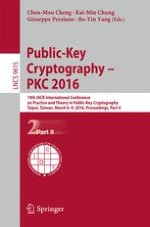2016 | Buch
Public-Key Cryptography – PKC 2016
19th IACR International Conference on Practice and Theory in Public-Key Cryptography, Taipei, Taiwan, March 6-9, 2016, Proceedings, Part II
herausgegeben von: Chen-Mou Cheng, Kai-Min Chung, Giuseppe Persiano, Bo-Yin Yang
Verlag: Springer Berlin Heidelberg
Buchreihe : Lecture Notes in Computer Science
